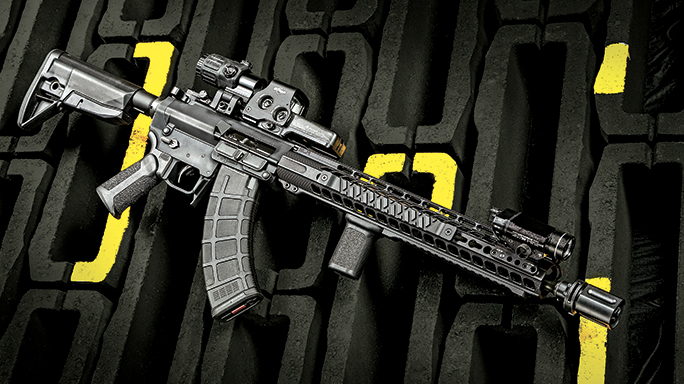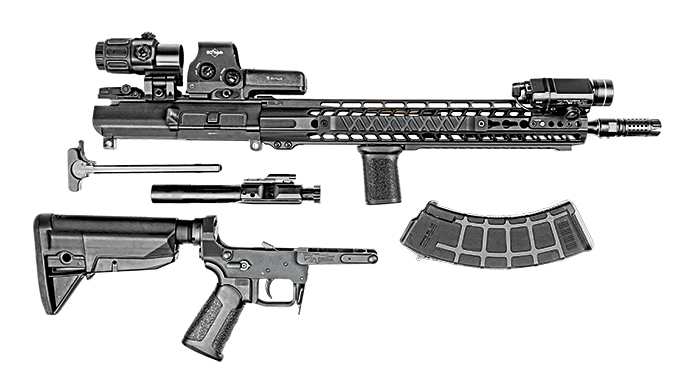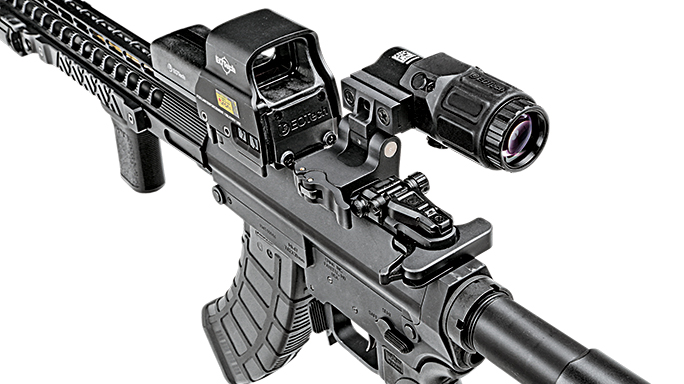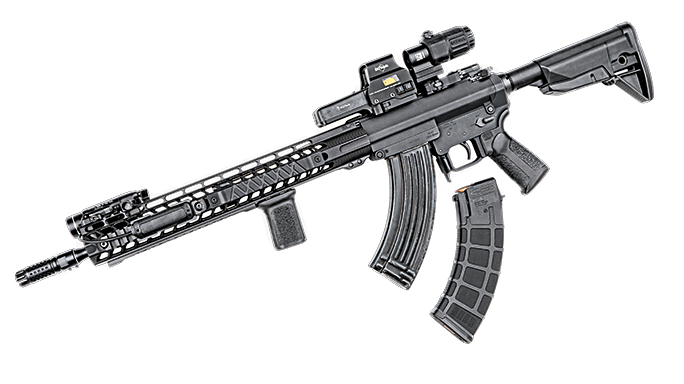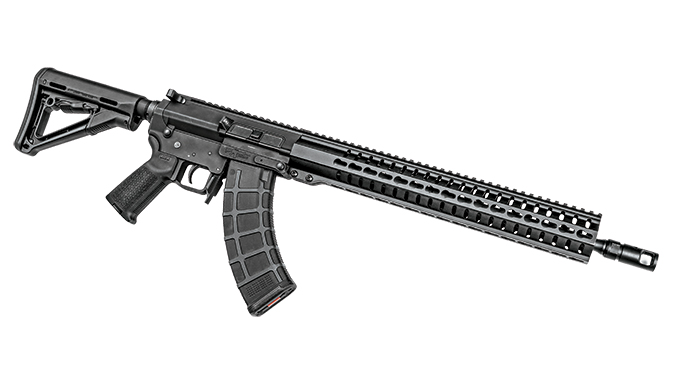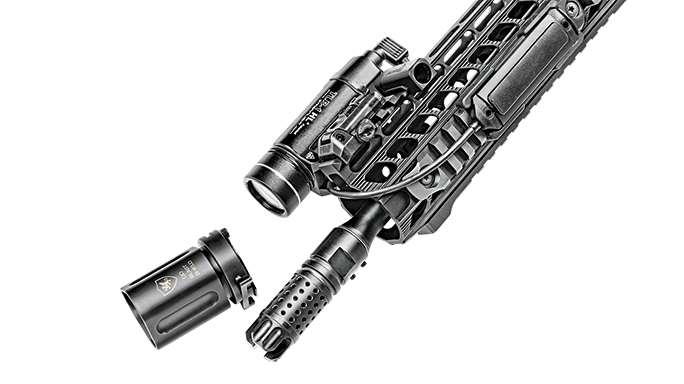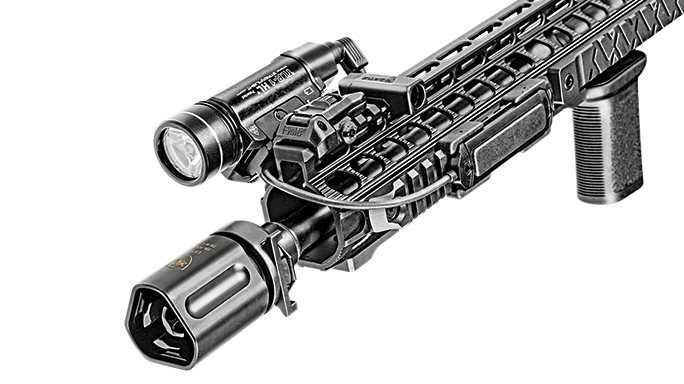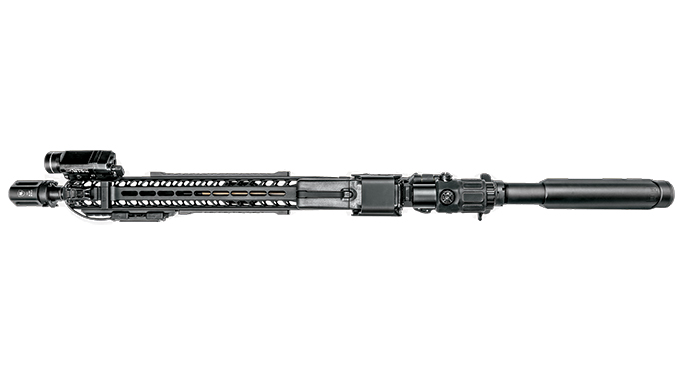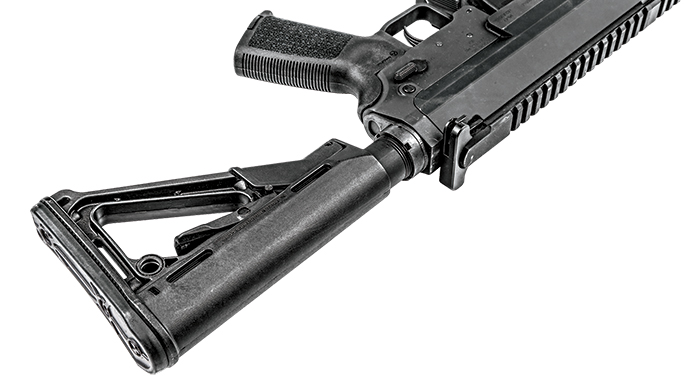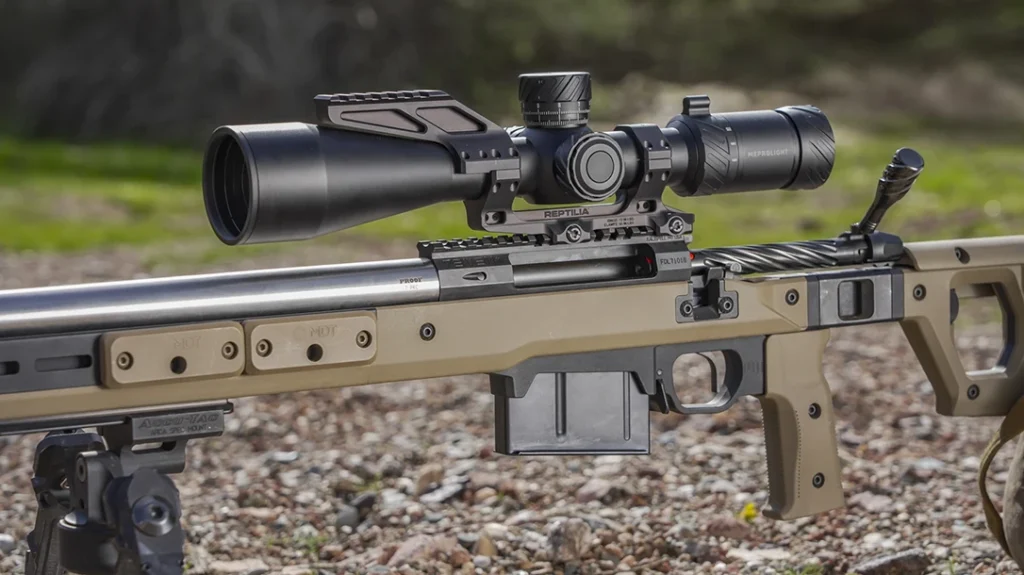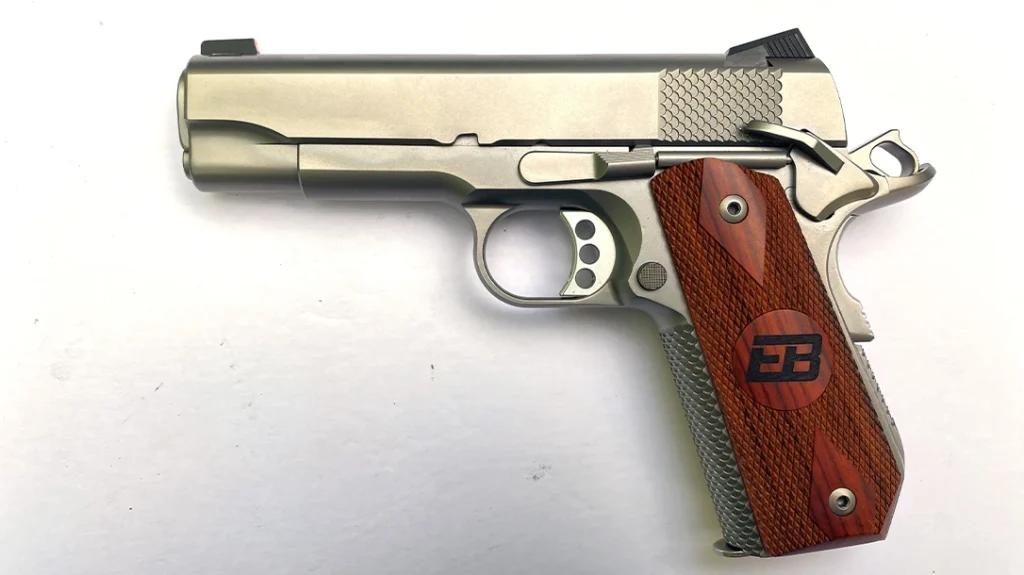There was a time when shooters had to choose between the accuracy and ergonomics of an AR-15 and the stopping power and reliability of an AK-47. The AR-15’s modularity and general user-friendliness have built it a rabid following that has endured for almost 60 years and is still going strong. The AK-47, on the other hand, has spawned a culture all its own and is one of, and is easily one of the most carried rifles in the world. The rifle is so important to some regions that its likeness even appears on a nation’s flag.
- RELATED STORY: Gun Test: CMMG Mk47 Mutant AKM in 7.62x39mm Rifle
For years, engineers and designers endeavored to find a good balance between the two platforms. Could it be possible to meld attributes from both rifles into one? For purists of both, that’s a blasphemous thought. For the rest of us, it’s a promising possibility worth looking into. Because we’re a nation of inventors and tinkerers, this topic has been engineered and reengineered six ways to Sunday, with many different approaches resulting in many more results.
The Strain
Advertisement — Continue Reading Below
Some approaches grafted the AK’s long-stroke piston system to an AR-15 to create an AK-inspired piston-system AR. Others kept the original gas system intact and rechambered the AR to take the AK’s man-stopping cartridge, the 7.62x39mm.
When tasked to find their own solution to this conundrum, the team at CMMG dove headfirst into the fray, and what they came up with is a remarkable rifle called the Mk47 Mutant.
Known primarily for its AR-15 rifles and drop-in .22 LR AR-15 conversion kits, CMMG has been deep in the trenches creating AR-style rifles and accessories for well over a decade. The company offers the traditional flavors of ARs, which are chambered in 5.56 NATO and .308 Win, as well as models in .22 LR, 9mm and 300 BLK. With all that experience building AR-platform rifles, it was natural that CMMG would apply its know-how to the creation of the Mk47.
Advertisement — Continue Reading Below
CMMG’s goal was to create a rifle that combines the strong points of both the AR-15 and AK-47. Loosely based on its Mk3 series of .308 Win chambered rifles, the aptly named Mutant fires a different breed of .30-caliber round, the 7.62x39mm.
Its receivers are machined from billet of 7075-T6 aluminum.
Lower Receiver Group
The Mk47’s lower receiver possesses all the control features an AR-15 shooter expects. Controls such as the grip, trigger, safety selector and charging handle are all where they “should be” when compared to an AR, so going through the familiarization process was almost nonexistent. Like a regular AR, the upper receiver goes on and comes off with the help of two captured pins in the lower receiver. As standard equipment, the rifle is equipped with a single-stage mil-spec AR-15-style trigger and Magpul MOE grip.
Advertisement — Continue Reading Below
What makes the lower receiver unique is the lack of a magwell and its ambidextrous, protruding, paddle-style magazine release. That and the fact that it can take just about any AK magazine you choose to feed it. The tricky thing about AK hybrids is getting the wide variety of AK magazines to function in them reliably. Funny thing is, even some AKs can’t do that right. The Magpul PMAG 30 AK/AKM magazine that came with our Mutant fit and functioned perfectly, as did a stack of old, metal-bodied surplus magazines we tried. Unfortunately, we weren’t able to try any drum magazines or other mags such those made by TAPCO or U.S. Palm, but we hear that they also work in the Mk47.
Our “AKM” model came with a Magpul CTR carbine stock fitted to a mil-spec-sized buffer tube at the rear. A special Mk47 weighted buffer hit the scales at 3.9 ounces. That’s a tenth of an ounce heavier than a standard carbine H-buffer. CMMG also offers two other models, including the no-frills Mk47 T, which comes with standard A2-type parts, and the top-tier Mk47 AKM2, which, like our AKM model, comes with a Magpul MOE grip and CTR stock along with a crisp two-stage Geissele SSA trigger.
Upper Receiver Group
Advertisement — Continue Reading Below
The upper receiver houses a 16.1-inch, medium-taper barrel made of 4140 chrome-moly steel that is salt bath nitrided inside and out for durability. The Mk47 uses a direct gas impingement system with a low-profile gas block installed on the barrel. It is fixed in place by setscrews and not pinned. The rifling features a 1:10-inch twist rate, and the barrel is threaded to a standard 5/8-24 thread pitch, which means you can equip it with any similarly threaded .308 Winchester/7.62mm NATO muzzle device without having to cut new threads. A CMMG SV Muzzle Brake comes standard.
Surrounding the barrel and a low-profile gas block is CMMG’s RKM15 free-floating handguard system. The 15-inch-long rail is the same you’ll find on certain Mk3 models and is completely modular. The entire top length is covered with Picatinny rail, while the sides and bottom can accommodate KeyMod attachments. No iron sights are included, so you’ll need to furnish your own if you choose to go that route.
The Mutant is powered by a carbine-length direct impingement gas system, similar to that of an AR-15. Along with the free-floating qualities of the rail, the gas system should also help the Mk47 in the accuracy department. Unlike the Mk47, the AK-47 requires a piston to cycle the action, which can hinder its accuracy. To help the Mk47 reliably fire the 7.62x39mm cartridge, it shares the Mk3’s bolt technology, which was originally designed to fire the similar-diameter .308 Win bullet. So what we end up with essentially is a rifle that fires AK rounds by using a variation of beefy internals based on the guts of a .308 AR. Simple but effective.
Advertisement — Continue Reading Below
Bang Time
In its standard form, the Mk47 performed smoothly and without any hiccups. The trigger pull was a consistent 8.2 pounds on our Lyman gauge with a very clearly felt and heard reset. Because we are much more proficient with ARs than AKs, the Mutant’s AR-like ergonomics are very much welcome. The Mk47’s controls were familiar to us, so it took no time getting comfortable with its operation. One major difference, however, is the lack of a bolt catch. On an AR-15, the bolt catch helps lock the bolt back as well as release it. The Mk47 has no such feature. This serves as a reminder that it is related to the AK in yet another way than its chambering.
Magazine changes can be tricky for the uninitiated when working with an AK, but in the case of the Mk47, reloading was a breeze. Its oversized magazine release paddle is easy to get to on either side of the rifle. The paddle was just out of reach for our trigger finger, so we used our off hand or another magazine to hit the paddle to release the expended magazine. Our polymer PMAGs and steel surplus mags all rocked into place with ease, and like in a typical AK, there is some play that allows the magazines to rattle around a little bit. Completely full magazines exhibited a little resistance to being quickly locked in and fully seated, but downloading them a round or two solved that problem.
Advertisement — Continue Reading Below
Another reminder that the Mk47 is a distant relative of the AK is that the bolt does not hold open after the last round is fired. Perhaps it’s due to our unfamiliarity with the rifle, but there seemed to be little in the way of physical clues when the rifle runs dry other than a limp trigger.
We ran two types of ammo through it, and it was ever hungry for more. The steel-cased Wolf Military Classic is a relatively inexpensive round that features a 124-grain, bi-metal bullet. Because we’d rather not poke holes in our steel targets and the fact that the harder bi-metal projectiles are a no-go at many ranges, we also sampled the 123-grain, full-metal-jacketed, lead-core rounds made by Red Army Standard. Both types of ammunition did their job well, feeding smoothly and consistently getting us hits on target. We did notice, however, that the ejected steel casings started to scuff up the aluminum upper receiver’s shell deflector pretty good. Given time and a lot more rounds, we can see the deflector getting awfully chewed up.
Because it fires the same 7.62x39mm round as most AK-type rifles, we anticipated recoil similar to that of a traditional AK we brought along to the range. Somewhat surprisingly, the Mk47’s recoil impulse felt less—and with less muzzle rise—than that of the AK, allowing us to keep follow-up shots on target quicker and in a tighter group. At 50 yards, standing, we consistently nailed a 6-inch metal gong with ease. When we pushed it back to 100 yards to shoot supported on paper with the help with a nonmagnified 4-MOA red dot, we got 2- to 3-inch groups using either variety of the steel-cased ammo. We attribute the smooth shooting characteristics to its AR-15-style direct gas impingement system over the AK’s gas piston system. The Mk47’s SV muzzle brake also seems much more effective than the traditional slant brake on the AK. With a magnified optic and higher-grade ammo, we’re sure the groups would be tighter.
Advertisement — Continue Reading Below
Back In The Lab
As well as the Mk47 Mutant AKM performed straight out of the box, we wanted to see if we could enhance its ergonomics and performance characteristics by decking it out with some gear. After our initial outing with the Mk47, we brought it back to the lab and configured it with a few aftermarket parts. Plus, we were just plain curious how many off-the-shelf aftermarket AR parts would work on it.
To help with sighting, we added a set of Magpul MBUS Pro backup iron sights and EOTech’s Model 518 holographic sight and Model G33.STS Magnifier. EOTech’s Model 518 is new for this year and features a distinctive reticle with a 68-MOA ring surrounding a 1-MOA dot for ultra-fast target acquisition. Commonly found AA batteries power it, which is a plus in our book. The 3X magnifier sits on a mount that is not only quick-detachable but can be flipped to the side as well.
Advertisement — Continue Reading Below
For a slightly lighter package and some additional style points, we went ahead and swapped out the factory rail for an SLR Rifleworks 15-inch Solo Ultra Lite Series KeyMod handguard. The replacement rail is the same length, but it is about a quarter-inch smaller in diameter and, taking into account the barrel nuts, lighter by 6 ounces. Realistically, the small weight savings are negligible considering the other parts we added, but any weight we could shave off to compensate for the weight we were adding is a good thing.
Up front we decided to try out Griffin Armament’s 30SD Flash Comp. We’ve heard great things about it and wanted to see if it could further tame the 7.62x39mm round. Because we often shoot near other shooters, we also attached the Griffin Armament QD Blast Shield to see if it really does project concussive force forward. Yes, we’re thoughtful like that.
Control-wise, we replaced the factory-installed furniture with Bravo Company’s Gunfighter stock in the rear and a short, KeyMod vertical foregrip in the front. To further optimize its operation, we also installed a Geissele Automatics Super 3 Gun single-stage trigger, XTech Tactical ATG pistol grip and a CMMG ambidextrous safety. We also installed Vltor KeyMod modular grip panels to three sides of the handguard to add traction and help shield some heat away from the shooter’s hands.
For sling attachment considerations, we swapped out the standard end plate for a BCM Gunfighter QD end plate in case we wanted to use a single-point sling. For two-point sling usage, we already had a built-in QD mount in the stock but needed a counterpart in the front. We mounted a Fortis RAP just behind the front iron sight on the topside of the rail as a forward QD sling swivel attachment point.
We like having the ability to see and shoot in the dark, so we fitted a 630-lumen Streamlight TLR-1 HL long gun kit to the front of the Mutant with the help of a BCM KeyMod light mount and 5.5-inch aluminum Picatinny rail section. Streamlight’s long gun kit includes a remote pressure switch with retaining clips to keep the pad in place on the rail section.
We found that the Mk47’s charging handles is a proprietary length, so neither AR-15 nor .308 AR charging handles can be used as a drop-in replacement. We worked around this by installing a replacement Badger Ordnance Gen II tactical latch in place of the standard one.
Bang Time Redux
After kitting out the rifle, we returned to the range to see if our reconstruction efforts paid off. Compared to its stock weight, the modified version added almost 3 pounds, bringing it up to an overall weight of 10 pounds flat. Even though that might be on the heftier side for a carbine, one should consider the trade-off in weight for increased capabilities of the rifle with a holographic sight, 3X magnifier, flashlight and other improved functions.
We engaged a mixture of paper and steel targets from 15 to 75 yards while on the move and in fixed positions. The most noticeable changes were to the trigger feeling and muzzle control. The Geissele Super 3 Gun trigger is by far one of our favorite single-stage triggers, with a very clean break and sub-4-pound pull. Repeated shots on target were made easier and, more notably, quicker due to the trigger upgrade. We did, however, run into a few light primer strikes on the last round with the trigger installed. The particular trigger we used has seen a lot of action; perhaps its springs need to be replaced.
The Griffin Armament 30SD Flash Comp certainly lived up to its reputation. It made a noticeable difference in easing the muzzle rise and overall felt recoil of the 7.62x39mm. Unfortunately, we ended up not being able to shoot at night, so its flash compensation properties couldn’t be seen.
We were, however, able to find out if the QD Blast Shield lived up to its purpose. When standing a couple of feet away from the Mk47 at its 3 o’clock position, the force from the muzzle device is clearly noticed. We attached the QD Blast Shield to see if it performed as advertised. The good news is that the concussive forces are indeed redirected forward and away from the shooter – and in this case away from human blast gauge standing next to it. But with it attached, we felt an immediate and noticeable increase in the rifle’s recoil. This makes sense, because instead of allowing the Flash Comp to direct the forces up and to the sides, it forces them forward, thereby pushing the rifle backward into the shooter’s shoulder. We were shooting outdoors, and of course the blast from the Flash Comp would certainly be even more pronounced indoors, making the QD Blast Shield a welcome addition in those situations.
Final Thoughts
In terms of its ergonomics, accuracy and brute stopping power, CMMG’s Mk47 Mutant certainly does blend some of the best attributes of the AR-15 and AK-47 together into one package. The CMMG Mk47 feels like an AR that spits out AK lead, both good things in our book. The major question we have is how it holds up under hard use in the field when compared toe to toe against a traditional AK and its related variants. Its direct gas impingement system is completely AR-15 and a 180-degree departure from the AK-47’s rugged long-stroke gas-piston system. Regrettably, we weren’t able to keep the Mk47 for extended trials, so that will remain a debate for another time.
- RELATED VIDEO: Firing CMMG’s New MK47 Mutant Hybrid at the Range
In terms of visceral enjoyment, the Mk47 is a thrill to shoot and a good-looking rifle,
to boot. While it does have its weaknesses, such as the lack of a bolt catch, the Mutant takes a leap in the direction we believe AR/AK mash-ups should be headed. CMMG set out to create a rifle that harnesses the best attributes of the AR-15 and AK-47, and it looks as if it was able to do so.
For more information on the Mk47, visit cmmginc.com.
Featured Accessories (Not Included):
Sights:
- EOTech Model 518 Holographic Sight
- EOTech Model G33.STS Magnifier
- Magpul MBUS Pro Sights
Control:
- Badger Ordnance Gen II Tactical Latch
- BCM Gunfighter Vertical Grip Mod 3 – KeyMod
- BCM Gunfighter Stock
- BCM Gunfighter QD End Plate
- CMMG Ambidextrous Safety Selector
- Fortis RAP – Rail Attachment Point
- Geissele Super 3 Gun (S3G) Trigger
- Griffin Armament 30SD Flash Comp
- Griffin Armament Blast Shield
- SLR Rifleworks 15” Solo Ultra Lite Series KeyMod Handguard
- Vltor KeyMod Modular Grip Panels (6” and 8”)
- XTech Tactical ATG Pistol Grip
Light:
- Streamlight TLR-1 HL Long Gun Kit (69262)
- BCM Gunfighter 1913 Light Mount Modular – KeyMod
- BCM 5.5” Aluminum Picatinny Rail Section – KeyMod
